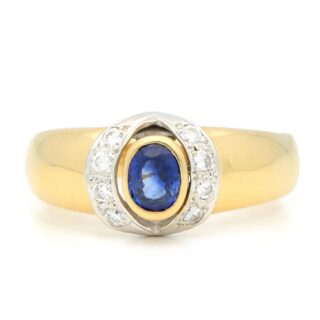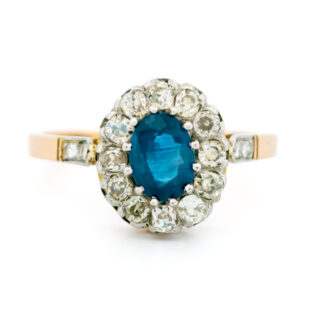This stunning vintage quatrefoil ring is a perfect way to add a touch of elegance to any look. Set with four sparkling sapphires totaling approximately 0.60 carats, and five brilliant-cut diamonds totaling approximately 0.05 carats, it is a timeless piece crafted from 9k gold. Made in Sheffield, UK.
Videos
Details: four totaling ±0.60ct Sapphires, five totaling ±0.05ct Brilliant-cut diamonds, 9k Ring.
Design Era: Vintage.
Size: 16.31 NL / 51.2 FR / 5¾ US / L UK, sizeable (Within reason. Contact seller for information).
Dimensions: H 0.4 x L 1 x W 1 cm.
Weight in grams: 2.
Condition: New.
Shipping and Pickup: This elegant piece ships from our store located in the center of Amsterdam, The Netherlands. We offer both registered shipping and local pickup at our store. In the case of local pickup, any applicable shipping costs will be refunded.
About Us: Add some sparkle to your style with Binenbaum.com. We offer a stunning selection of antique and vintage jewelry that you won’t find anywhere else. From timeless rings and dazzling necklaces to unique brooches, we have something for every taste and occasion. Visit our website today and treat yourself to a piece of history.
| Design Era | |
|---|---|
| Design & Historical Context | Vintage jewelry refers to jewelry that was produced a certain number of years ago, typically at least 20 years or more. It is often characterized by its unique style, craftsmanship, and use of materials that are no longer in production or are hard to find. Vintage jewelry can be made from a wide variety of materials, including gold, silver, platinum, and diamonds, as well as less precious materials such as costume jewelry or Bakelite. It can be influenced by a variety of styles and movements, including Art Deco, Art Nouveau, and Retro. One of the key features of vintage jewelry is its uniqueness and individuality. Unlike modern jewelry, which is often mass-produced, vintage jewelry is often one-of-a-kind or part of a limited production run. This makes it highly collectible and sought after by collectors and vintage enthusiasts. Vintage jewelry is often associated with a sense of history and nostalgia, and it can be a way to connect with the past and appreciate the craftsmanship and artistry of earlier periods. It is highly collectible and can be found at vintage stores, antique shops, and online marketplaces. |
| Key Materials | |
| Materials & Craftsmanship | Sapphire: The Gem of Wisdom and Royalty Sapphire, known for its stunning deep blue color, is a gemstone that embodies wisdom, loyalty, and nobility. This precious stone is a variety of the mineral corundum, and while blue is the most famous color, sapphires can also be found in a range of hues, including pink, yellow, green, and even colorless. Historically, sapphire has been revered across cultures for its association with the divine and the eternal. In ancient Persia, it was believed that the sky was painted blue by the reflection of sapphire stones. Throughout the ages, sapphire has been favored by royalty and clergy as a symbol of purity, virtue, and divine favor. Perhaps the most famous modern example is the sapphire engagement ring worn by Princess Diana and now by the Duchess of Cambridge. In jewelry, sapphire is celebrated for its beauty and durability, boasting a Mohs hardness of 9, second only to diamond. This makes sapphire an excellent choice for rings, necklaces, and earrings intended for everyday wear. The stone’s intense color and clarity are often highlighted by settings in white gold or platinum, though yellow gold can also enhance its warmth and depth. Sapphire is more than just a gemstone; it is a symbol of wisdom, fidelity, and nobility. Its rich history, combined with its remarkable durability and beauty, makes it a timeless and elegant choice for jewelry that signifies enduring love and commitment. Brilliant-cut diamond: The Pinnacle of Sparkle and Brilliance The brilliant-cut diamond is the most popular and widely recognized diamond cut in the world, renowned for its exceptional sparkle and fire. This cut, perfected over centuries, is designed to maximize the reflection of light, creating the dazzling brilliance that has made it the standard for diamonds in modern jewelry. The brilliant cut features 58 facets—33 on the crown and 25 on the pavilion—carefully arranged to capture and reflect light from every angle. The precision of these facets ensures that light entering the diamond is reflected internally and dispersed into a stunning array of colors, giving the stone its characteristic brilliance. Historically, the brilliant cut evolved from earlier cuts like the Old European and rose cuts, with advancements in diamond cutting technology and understanding of light reflection. This modern cut became widely adopted in the early 20th century and quickly became the preferred choice for engagement rings and other fine jewelry, due to its unmatched sparkle. In modern jewelry, brilliant-cut diamonds are prized for their versatility and unmatched brilliance. They are the go-to choice for engagement rings, earrings, pendants, and virtually any jewelry piece where a classic, sparkling diamond is desired. The round shape and symmetrical design make the brilliant cut ideal for showcasing the inherent beauty of the diamond, regardless of its size. A brilliant-cut diamond is more than just a gemstone; it is a symbol of timeless beauty and perfection. Its unparalleled sparkle and universal appeal make it the quintessential choice for jewelry that celebrates life's most precious moments. 9k: The Affordable and Durable Choice with a Subtle Golden Hue 9k gold is a cost-effective and sturdy option in the world of fine jewelry, particularly popular for those seeking the look of gold at a more accessible price point. The "9k" indicates that the gold is composed of 37.5% pure gold, with the remaining 62.5% made up of alloyed metals such as copper, silver, nickel, or zinc. This higher proportion of alloyed metals results in a more durable and harder material, making 9k gold an excellent choice for everyday wear. Historically, 9k gold has been favored in regions like the United Kingdom and Australia, where it is legally recognized as gold. It offers a balance between the luxury of gold and the practicality of more affordable metals, making it accessible to a wider range of people. In modern jewelry, 9k gold is appreciated for its durability and subtle color. While its gold content is lower than that of 14k or 18k gold, it still retains a warm, golden hue, though it is slightly paler. The color of 9k gold can vary depending on the metals used in the alloy: Yellow Gold: 9k yellow gold has a softer, more subdued golden color compared to higher karat golds, but it still carries the classic warmth and appeal of gold. White Gold: 9k white gold has a faint golden tint beneath its white finish, which is often enhanced with a rhodium plating to give it a brighter, more silvery appearance. Rose Gold: 9k rose gold, made by adding more copper to the alloy, has a delicate pinkish hue that is slightly more muted than higher karat rose golds but still carries a romantic charm. 9k gold is commonly used in rings, earrings, bracelets, pendants, and other jewelry that is designed for daily wear. Its increased durability means it is less prone to scratching and bending, making it a practical choice for pieces that are worn regularly. 9k gold is more than just an affordable alternative; it is a symbol of practical luxury and everyday elegance. Its durability, combined with its subtle and warm color, makes 9k gold a popular choice for those who want the beauty of gold with the added benefit of strength and affordability. Whether in a simple design or an intricate piece, 9k gold offers a lasting and attractive option for jewelry that can be cherished daily. |
| Size | |
| Dimensions | H 0.4 x L 1 x W 1 cm |
| Gender | |
| Weight (in grams) | 2 |
| Condition |
Enhance the Beauty of Your Jewelry with Proper Care
Wearing your jewelry is a special way to express yourself and add a touch of personal style to any look. However, to ensure your jewelry remains in pristine condition, there are a few simple steps you need to take to keep it looking its best.
General Care Instructions:
Remove jewelry when showering or bathing, especially when at the beach, in the sea or in chlorinated water.
Avoid wearing jewelry while doing physical work such as housekeeping, gardening or exercise.
Storing your jewelry in a dry and cool place will help protect it from moisture, dirt and dust.
Keeping it away from harsh chemicals such as bleach, ammonia and chlorine will help to avoid discoloration and damage.
Cleaning your jewelry regularly with a soft cloth will help to keep it looking shiny and new.
Avoid exposing your jewelry to extreme temperatures, such as leaving it in direct sunlight or near a heater, as this can cause damage.
Handle your jewelry carefully and avoid dropping it, as this can cause the stones to loosen or the metals to scratch.
Finally, if possible, have your jewelry professionally checked and serviced. This will ensure that any potential problems are spotted and fixed before they become worse.
By following these tips, you can enjoy your precious jewelry for many years to come.
Related Products
-
Diamond Sapphire 18k Ring 16158-8726
€ 1.995,00Original price was: € 1.995,00.€ 1.695,00Current price is: € 1.695,00. VAT incl. (where applicable) -
Sapphire Diamond 14k Cluster Ring 12864-8041
€ 2.395,00 VAT incl. (where applicable) -
Diamond Sapphire 14k Gypsy Ring 15965-8686
€ 3.495,00 VAT incl. (where applicable) -
Diamond Emerald Sapphire 18k “Bi-Color Band” Ring 15871-8660
€ 2.695,00 VAT incl. (where applicable) -
Diamond Sapphire 18k Platinum Cluster Ring 15021-5117
€ 3.495,00 VAT incl. (where applicable) -
Diamond Sapphire 18k Halo Ring 12785-7050
€ 7.995,00 VAT incl. (where applicable) -
Diamond Sapphire 18k Cluster Ring 10786-6692
€ 1.395,00 VAT incl. (where applicable) -
Diamond Sapphire 18k Platinum Trilogy Ring 14408-5114
€ 3.295,00 VAT incl. (where applicable)
- Home
- Collection
- Fine Jewelry
- Silver Jewelry
- Silverware
- Boxes
- Candlesticks
- Salt and pepper shakers
- Miniatures
- Salt cellars
- Spoon Set
- Condiments
- Frames
- Napkin Ring
- Spoon
- Oddities
- Cups
- Vases
- Cutlery
- Serving Spoon And Cake Server
- Candlesticks
- Baskets
- Hanukkiah
- Spice Tower
- Yad
- Tea Set
- Sugar Castor
- Napkin Rings
- Wine Bottle Coaster
- Wine Stopper
- Tea Pot
- Jugs
- Rattles
- Hip Flask
- Miscellaneous
- Rings 💍
- About
- Contact






















